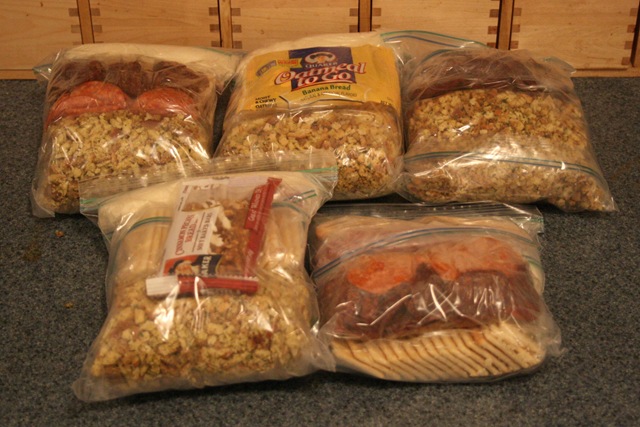Im interested in this with a week long trip coming up soon. Looking at your loadout you usually have your down duvet taking up a third of the pack and your WM puma must take up another good chunk (i have the kodiak and thats big enough). How much space does 10 days dired rats take up? and what sort of stuff to you tend to go for? im imagining you need pretty high levels of calories if you are going up hill a lot.
The Western Mountaineering Puma sleeping bag compresses in a size L Sea to Summit stuff sack. The way the stuff fits in the Gregory Palisade is that the Puma (compressed) and the Shangri La 3 go side by side along the back of the pack. In front of the Shangri-La I place the rolled up NeoAir All Season sleeping mat. On top of the sleeping bag I have my 2L pot, with the stove inside (if using a white gas stove, the fuel bottle is outside of the pot). On top of the NeoAir mat, in front of the Shangri-La 3 I place my first aid kit, and other small stuff sacks with headlamp, etc. That's also where I place the pee bottle (folded up). On the side, along the sleeping bag I place the saw. That takes up a bit less than 2/3 of the pack. The rest can be arranged however you want depending on what you are taking. In the picture you saw before, I only had three days of food with me, so I had plenty of room left. I had my crampons inside, and my down jacket was not compressed in a stuff sack. If I had more food with me, I would put the down jacket in its stuff sack, and I may even move the crampons to the outside of the bag if more room was needed.
As far as food, I aim for about 115 cal/oz (404 cal/g is my math is correct-probably not). That means 2000 cal weighs a bit over 1lb (0.45 kg). Depending on how many calories you plan to use up, the weight of the food for 10 days can be anywhere from 10-20lb (4.5-9 kg). As far as volume, the bag I am holding in the picture below contains five days of food at 2000 cal per day. The contents was not as compact as it could have been because I had brought some bulkier items. For that size you can bring about 7 days of food at 2000 cal per day.
The main staple of my food is mashed potatoes. They are very light and pack well. In the above picture I had replaced some of the mashed potatoes with Stove Top stuffing, which while weighing the same per calorie, is much bulkier. Instant oatmeal, nuts, salami and crackers round up the foods. Chocolate is a good calorie dense option, but I am lactose intolerant, so I can't really use it.
So, the five days of food from the above picture looked like this:
Here is the food for each individual day. Notice how much larger the stove top on the right is than the mashed potatoes on the left.
On the issue of calories per day, there are two considerations. The first is that the body (at least mine) has a hard time consuming much more calories than it does on daily bases. It takes time for the body to ramp up to consume 6000 per day. When you start out a trip, odds are that even if you tried, you would not be able to consume that much food. For a week long trip, it would be hard to consume the large caloric intake we see people use on arctic expeditions.
The other thing is, we often overestimate the calories needed. If you are pulling a sled across Antarctica for 13 hours a day, then you do indeed need 6000-8000 cal per day. If however, you pull a sled for a mile, set up camp, and then spend the rest of the day by the fire, we are much closer to the 2000 cal per day. If the second or third day of the trip does not require any travel, then the needed calories will drop even further despite the fact that it's cold.
Now that we have hijacked the thread completely, let me know if you need any more details.








